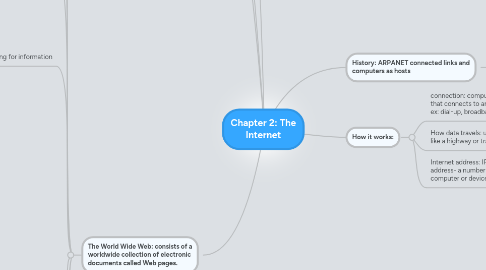
1. The World Wide Web: consists of a worldwide collection of electronic documents called Web pages.
1.1. website: a collection of related Web pages and associated items such as documents and pictures, stored on a web server.
1.1.1. web server: a computer that delivers requested Web pages to your computer
1.2. browsing the web:
1.2.1. browser: an application software that allows users to access and view Web pages
1.2.2. homepage: refers to the first page that a web site displays
1.2.3. downloading: the process of a computer receiving information such as a web page from a server on the internet.
1.3. web address: URL: uniform resource locator
1.4. navigating the web pages
1.4.1. link: short for hyperlink is a built-in connection to another related web pageor part of a web page
1.4.2. hypertext: refers to links in text-based documents
1.4.3. hypermedia: combines text-based links with graphic, audio, and video links
1.4.4. surfing the web: refers to the activity of using links to explore the web
1.5. searching for information
1.5.1. search engine: a program that dins web sites, web pages, images, videos, news and other information related to a specific topic.
1.5.2. subject directory: classifies web pages in an organized set of categories such as sports or shopping
1.6. types of websites
1.6.1. portal: a web site that offers a variety of internet services from a single convenient location
1.6.1.1. online community: a web site that joins a specific group of people with similar interests or relationships
1.6.2. news: contains news worthy material including stories and articles relating to current events, life, money, sports, and the weather
1.6.3. informational: contains factual information
1.6.4. business/ marketing: contains content that promotes or sells products or services
1.6.5. educational: offers exciting, challenging avenues for formal and informal teaching and lerning
1.6.6. entertainment: offers and interactive and engaging environment
1.6.7. advocacy: contains content that describes a cause, opinion, or idea
1.6.8. blog: Weblog: an informal website consisting of time-stamped articles or posts, in a diary or journal format, usually listed in revers chronological order
1.6.9. wiki: a collaborative website that allows users to create, add to, or modify, or delete, the website content
1.6.10. online social network: a web site that encourages members in its online community to share their interests, ideas, stories, photos, etc
1.6.11. content aggregator: a business that gathers and organizes web content and then distributes or feeds the content to subscribers for free or for a fee
1.6.12. personal: a private, individual, or family not usually associated with any organization may maintain a personal web site or just a sungle web page
1.7. multimedia on the web
1.7.1. graphics: a digital representation of a nontext information such as a drawing, chart or photo
1.7.2. animation: the appearance of motion created by displaying a series of still images in sequence
1.7.3. audio: includes music, speech, or any other sound
1.7.3.1. mp3: reduces an audio file to about one tenth its original size
1.7.3.2. streaming: the process of transferring data in a continuous and even flow
1.7.4. video: consists of full-motion images that are played back at various speeds
1.7.5. virtual reality: the use of computers to simulate a real or imagined environment that appears as three-dimensional space
1.7.6. plug-ins: or add on is a program that extends the capability of a browser
1.8. web publishing: the development and maintinence of web pages
2. E-commerce: electronic commerce: a business transaction that occurs over an electronic network such as the internet
3. other internet services
3.1. email: the trasmition of messages and files via computer network
3.2. mailing lists: a group of e-mail names and addresses given a single name
3.3. instant messaging: a real-time internet communications service that notifies you when one or more people are online and then allows you to exchange messages or files or join a private chat room with them
3.4. chat rooms: real-time conversation that takes place on a computer
3.4.1. real-time: means that you and the people with whom you are conversing are online at the same time
3.5. VoIP: internet telephony, enables users to speak to other users over the internet
3.6. FTP: the internet standard that permits file uploading and transferring with other computers on the internet
3.7. newsgroups and message boards: an online area which users have written discussions about particular subjects
4. NETIQUETTE: the code of acceptable behaviors users should follow while on the internet
5. History: ARPANET connected links and computers as hosts
5.1. host: more commonly known as a server
6. How it works:
6.1. connection: computers are part of a network that connects to an internet access provider. ex: dial-up, broadband DSL
6.1.1. access provider: a business that provides individuals and companies access to the internet free or for a fee
6.2. How data travels: use servers and clients. works like a highway or transportation system.
6.2.1. Internet backbone: carriers of network traffic
6.3. Internet address: IP address- internet protocol address- a number that uniquely identifies each computer or device connected to the internet.
6.3.1. not easy to remember, so the internet uses a text name that represents one or more IP addresses
